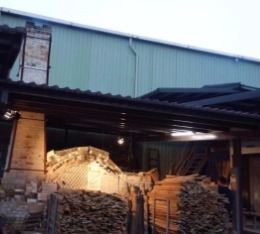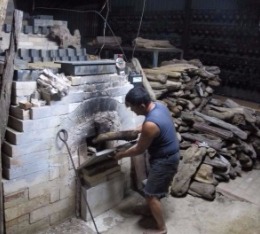Eco-friendly wood-firing
By: Teng Shu-Hui and Serina Sheng
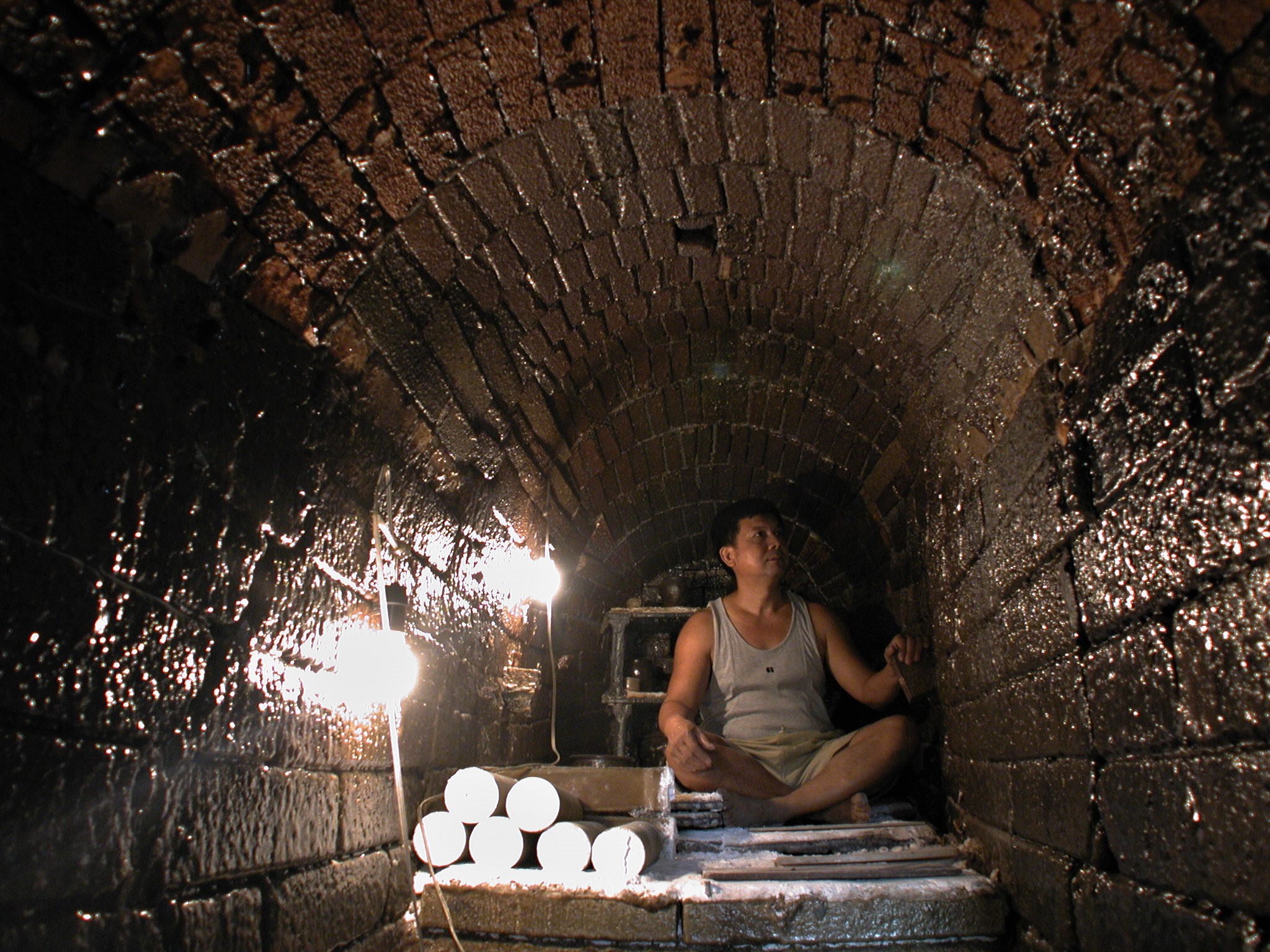
A lot of people mistakenly think wood-firing is harmful to the environment: wood is burnt, trees are cut, and black smoke is created. However, in fact, wood-firing is the most environmentally friendly way to fire ceramics. It can even become an eco-friendly lifestyle that revolutionizes the values of human civilization. Below, the eco-friendly wood-firing strongly promoted by Lin Jui-Hwa is explained from three perspectives: Overturning Conceptions, Operation in Practice, and Ideals.
Overturning Conceptions
(1) Wood-firing does not necessarily need to generate large amounts of black smoke to produce the "reduction" effect.
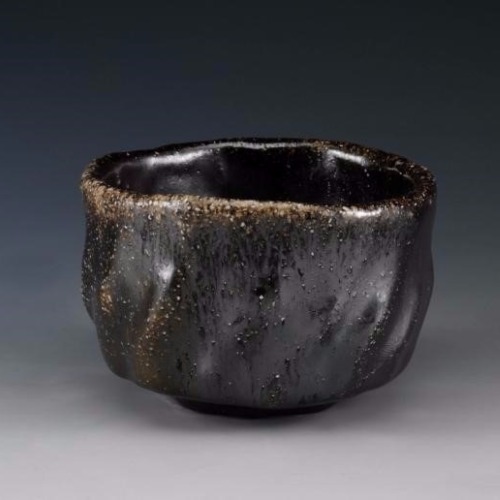
▲無黑煙也可以有強還原的效果
Many people who fire kilns emphasize the reduction process for the alluring color change or the better tea taste. However, the reduction process during wood-firing is not necessarily connected to black smoke. Smoke is just one of many ways to produce strong reduction during wood-firing.
Looking more closely, both oxidation and reduction are always happening in wood-firing. A good reduction effect can be generated without black smoke. Even without reduction, many gorgeous textures can be created in the kiln. The fascinating part about wood-firing is finding your own style from the myriad of natural aesthetics. For those who like wood-fired kilns, there's no need to fixate on achieving reduction by creating black smoke. Only when you make an effort to avoid producing black smoke can you find a place in the community, the lifestyle aesthetics of wood-fired ceramics can be accepted by more people, and the artist can return to the community. More than two decades ago, Lin Jui-Hwa also produced a large amount of smoke to achieve a higher temperature in the kiln. However, in recent years he has made an effort to improve his operating methods such that practically no black smoke is produced, while cutting down the amount of wood used by more than half. He is constantly chasing the goal of a lifestyle of energy conservation, reduced carbon footprint, and environmental friendliness.
(2) It's not hot during wood-firing! Conserving heat is our goal
People think that wood-firing means one needs to be sweating and frantically loading wood into the kiln. However, with proper preparation beforehand, wood-firing can be an effortless task.
If the kiln is built and fired correctly, the kiln body does not heat up, nor does it produce black smoke. The key lies in the correct operating method. The wood needs to burn completely in the kiln. Creating black smoke indicates that the wood was not burned completely, and the energy was not fully utilized. In other words, operating a wood-fired kiln is not hot if one can grasp the main aspects of the correction wood-firing method. This is important for the health of the operator: many people get exhausted or suffer a heat stroke when firing kilns, and that's a problem. If the operator cannot go near a kiln fired at merely 1000 degrees, requiring fireproof gloves and clothing, or the kiln spews fire, then there must be a problem with the kiln design. For kilns designed and built by Lin Jui-Hwa, one can comfortably stand by the kiln and load the wood when it's burning at 1300℃, 1400℃, or even 1500℃. It's less taxing on the operator, and better for the operator’s health as well. Eco-friendly wood-firing can be done effortlessly, and the cost spent on wood can be greatly reduced as well!
What's precious about wood-fired ceramics is not how hot, how difficult it is. It's the expression the artist’s unique aesthetics and wisdom relating to earth and fire using the most natural materials, and letting that beauty and wisdom continue to light the way towards a civilization of the future.
(3) Eco-friendly wood-firing only uses waste wood
The smoke produced during wood-firing can be recycled by nature, and is not harmful to crops. Lin Jui-Hwa's father, Lin Tien-Fu, had been firing the snake kiln for 60 years, but have never had to pay smoke pollution compensation to the surrounding farms, which usually thrived. From Zhunan Snake Kiln's own experience, it was surrounded by big ceramic factories in the neighborhood during the boom of gas kilns 20 years ago. Although no black smoke was visible, there was always a pungent smell in the air and the trees in the gardens of the Snake Garden never bore fruits. Now that the gas kilns of the big factories are no longer running, the birds and frogs have come back even as the wood kiln has been fired more than one hundred times. The trees too, bore bounties of fruits even without pesticides or fertilizers.
Most importantly, in the two-plus decades since coming back to wood-fired kilns, the Snake Kiln has used only waste wood as fuel and never cut down trees or bought lumber for its ceramic kilns. Instead, it has helped use up driftwood from the sea shores, or those that clog up Port of Keelung, or the fallen trees on highways after a typhoon. Aside from the above, the Snake Kiln uses only the leftover waste wood from sawmills.
Operation in Practice
In order to achieve eco-friendly wood-firing in practice, the following few pointers should be followed
First, you must have a good solid kiln. When constructing the kiln, the foundation must be built upon the earth rather than a concrete base. This is done for a sturdy structure, and to avoid cracks or even shifts in position due to the temperature-dependent expansion and contraction. Of special note is that the two sides are wide at the bottom and narrow at the top while slanting towards the middle chamber, and the kiln door slants backwards. In such manner the four sides join to create a strong structure that can withstand the thousand-degree heat and enormous kiln pressure. The kilns designed by Lin Jui-Hwa do not need to be reinforced by steel as it relies completely on the natural expansion of the arch to strengthen the structure.
Second, when loading the kiln, special care must be taken to keep the flame path clear from the front firebox to the chimney. When the green bodies are loaded into the kiln, the spatial relationship between the green bodies themselves, and between the green body and the chamber walls must be noted when arranging them. Regardless what type of quality and texture one is aiming for, the flame path must be kept clear. Do not mess with the fire just to squeeze in a few more clay bodies. A clear flame path contributes to the complete burning of wood, as basic requirement for eco-friendly wood-firing. The 2011 book New Era of High-Temperature Wood-fired Ceramics explains in great detail that a well-designed, well-built kiln is an absolute prerequisite for eco-friendly wood-firing. Only with a kiln where heat does not escape and the kiln operator is not worn out by the radiative heat, can the operator's health be ensured. Being eco-friendly includes protecting the health of the kiln operator.
Third is the thorough categorization and preparation of the firewood. The organization of the firewood requires years of accumulated experience as it demands thorough understanding of the characteristics of each type of wood. The species, oil and water content, and hardness of the wood can all affect the firing effect. The right firewood must be loaded at the right time to yield the best results. In addition to classifying by type, the wood must be separated by size into small, medium, and large when preparing for firing. Organizing firewood by size allows fast and convenient access to the required wood at any time when firing a kiln. This is why the preparation before firing often takes more time than the firing itself. From what I know, a lot of wood-firing groups do not prepare their firewood and instead grab any random firewood while firing. This creates three problems: the good wood is used up at medium and low temperatures by the people who man the earlier shifts; at high temperatures wood is not readily available and a frenzy ensues; and the waste of firewood when encountering a stall in temperature that results from lack of knowledge of firewood allocation and usage.
Every type of wood has its use, which is why organizing firewood on a regular basis is so important. Sorting every piece of wood by hand and having a variety of wood sources grant a complete understanding of every aspect of the wood. Only by thoroughly knowing the firewood to be used, can one interact with the kiln. The kiln will tell you what it needs, so the kiln operator needs to clear their mind to see the color of the flame and listen to the voice of the fire.
“Keys to fire control”: At the low temperature stage, use short and hefty wood to fill the entire firebox, reducing the air inflow at the firemouth to a minimum. The kiln is "slow cooking" at this point, and even rotten stumps can be used to dry the kiln at an extremely slow rate. At the low temperature stage, the slower the firing, the better. Many people overlook the effect of this stage on the wood-fired texture.
In the mid-temperature stage, the thick and short logs are fed with thinner pieces of wood. The air inlet should not be too big at this point to avoid letting cold air in. In this way, the temperature can be raised quickly without much black smoke. As for when the mid-temperature stage has been reached, the kiln will tell you when it has dried. There is no need to deliberately raise the temperature, rather care must be taken to stay restrained and not raise the temperature. Once the kiln temperature reaches around 600 degrees, it can be raised quickly. Restrained firing is the key at mid-temperatures. It's not just the clay bodies that need to warm up, one must wait for the kiln body to rise in temperature to accumulate the potential for the temperature to shoot up at higher temperatures. People often stall at high temperatures precisely because the kiln body has not absorbed enough heat. The temperature is stalled around 1000, 1200 degrees and heat is wasted during the temperature ramp-up. Lin Jui-Hwa's firing method requires only 30 minutes to two hours to go from 900 degrees to 1300 degrees. Beyond being energy-efficient, the instantaneous rise in temperature has another advantage - clay bodies do not crumble as easily. It's much like cooking noodles: if you cook for too long, the noodle becomes soggy; however if you put it in boiling water, the surface cooks rapidly and protects the inside from becoming soggy in the boiling water. This firing method consists of slow firing at low temperatures, restrained firing at mid temperatures, and rapid ramp-up at high temperatures.
To raise the temperature quickly at higher temperatures, we adopt the "Lin Wood-Firing Technique", so called because it's a special kiln firing technique passed down by Lin Tien-Fu. A long, thick log is used as the base with long, thin strips of wood placed on top. Sometimes the strips are fed crisscrossed to raise the temperature faster; sometimes they are fed slowly into the firebox.
There's the misconception that to raise the temperature further when the kiln is already hot, a large amount of air inflow is required. However, as long as heat conversion is sufficient, the air will be automatically drawn in rapidly. If you can sit in front of the kiln without feeling hot, that's a sign that the air is moving through rapidly. If you feel hot while operating the kiln, that means the heat energy is spilling over and being wasted. The vents are barely opened, or at most adjusted for a tiny opening. There is also no need to clear the coal deposits.
The last stage is soaking and sealing. This stage affects what type of effect and texture the artist wants to produce. This requires years of observations and sorting through those observations to come to conclusions that cannot be put in a few words. Normally, soaking at a high temperature tends to lead to the pieces melting, collapsing, and sticking. However, the final product will demonstrate different types of beauty that are truly amazing. As mentioned previously, buying time with high temperature can save on the amount of wood used and reduce the toll on the operator's body. Soaking alternately at high and low temperatures is also a good choice. Regardless how you soak, or how the kiln is sealed in the end, one must always remember wood-firing is a collaboration between man, earth, fire, and kiln. The kiln is more than a tool for production, it's your creative partner. A good kiln should last at least 30-50 years. The operator needs put his heart and soul into taking care of his own kiln. In the old days, people don't take tearing down their kiln lightly because they have spent years with their kiln and grown attached. Building a long-lasting kiln is also being eco-friendly and energy-efficient!
Ideals
There are a thousand different variations in the texture produced through wood-firing. We hope that every wood-fired ceramic artist can find a form that best expresses their emotions and creative concepts. From the clay formulation, shaping techniques, and temperature selection, to kiln arrangement and soaking techniques, these all affect the expression of textures and colors. For wood-fired ceramic art below 1350℃, the various texture and aesthetic expressions had all been explored in Japan 30 to 40 years earlier than in Taiwan. Ancient China had seen many brilliant accomplishments below 1400℃. The realm beyond 1500℃ is the only one unseen in the world to this day in the field of wood-fired ceramic art. There's a broad future ahead that deserves to be explored by more people.
(1) Exploring the Future
Wood-firing ceramics beyond 1500℃ is a world never reached by man. Much like deep sea or space exploration, it brings a further understanding of the universe and the life within. In the realm of high temperature wood-firing, whether it's through vertical temperature curve, or the horizontal change in clay, or temperature control methods within the same temperature range, there's a boundless future that remains to be explored. At these temperatures, many different textures are possible without the use of glaze, drastically reducing the need for mining and refining ore, and for extracting oil and natural gas, thereby cutting down on production processes that pollute the earth.
Using wood as the fuel, it is possible to reach 1600℃, 1700℃ through continued improvements; even reaching 2000℃ may just be a matter of time. In the future, the heat generated could be recycled for daily use and reduce our reliance on electricity.
(2) Reexamining Human Civilization
The human civilization began with fire, and the invention of the kiln brought human civilization to new heights. However, the materialistic civilization of mankind today is a world that is built through condensing, refining, and synthesizing. The non-renewable production of energy is also destroying the earth, while the large-scale mining of raw material to extract tiny amounts of usable substance is a waste of the earth's resources and causes major damage to the environment. If we humans continue down this path of creating material while incessantly consuming the earth's resources, it may spell disaster for mankind in the future.
The concept of eco-friendly wood-firing emphasizes more than being eco-friendly during the firing process. Starting with the clay, a product of nature, one must consider treating clay in a method that is least damaging to the environment: only taking as much as is required to make the pieces, with the new substances recyclable by nature. How many people have thought about how much ore is needed to refine into the porcelain clay to make a simple, inexpensive white or colored floral porcelain bowl? And how much energy is required to make glaze? Thanks to industrialization, the cost of these materials has become very low, but this creates an industry that mortgages the future. Using unrefined clay reduces the waste of resources. The some of the metal oxides used in ceramics art have gradually become more extreme, to the point where it may bring harm to individuals, the society, and even the earth. Using only mud, wood ash, and clay, an endless number of variations in the beauty of the pieces can be expressed by raising the temperature range or employing different soaking techniques. This is the core value of eco-friendly wood-firing.
Humans invented the kiln, gained control of fire, and thus created various civilizations. However, because civilization has developed in the direction of qualitative control and lower cost by mass production, we have pushed many organisms to the brink. We should rethink the direction of civilization, turn it around and start learning from scratch; that is how civilization can begin moving forward.
(3) "Future ceramics" - creating a better life
The goal of eco-friendly wood-firing is to create ceramics that benefit people's lives using the most natural method. Potter creates vessels that part of people's lives. When ceramic vessels created through eco-friendly wood-firing are used in our everyday life to store food or drinking water, it'll make them more delicious: the water will taste sweeter and more refreshing, and the food more savory. I call vessels made through eco-friendly wood-firing "future ceramics" because I believe this is the inevitable direction of the future. From an aesthetics point of view, it demonstrates an unprecedented quality, similar to gemstones or jades. It also presents various natural geodes, and even displays sceneries like those of galaxies and the universe. Ask yourself, why do underground springs or water in caves taste better than gourmet food? I believe learning from Earth and creating everyday vessels with texture akin to natural minerals to store water is a major contribution to the mankind.

▲Once the firing temperature is raised, the earth, ash, and fire come together to create countless changes like galaxies in the universe, waiting to be explored.
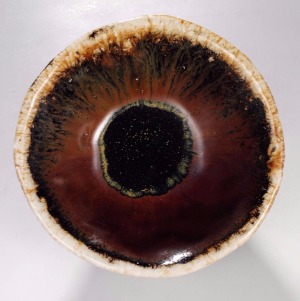
▲High temperature wood-firing results in textures like natural jade and geodes. Using it to hold water gives it a sweet taste that rivals natural springs.
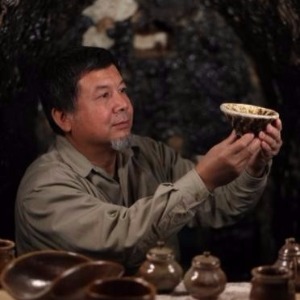
▲Learning from Earth, the greatest kiln, to pioneer a new direction for human civilization!




